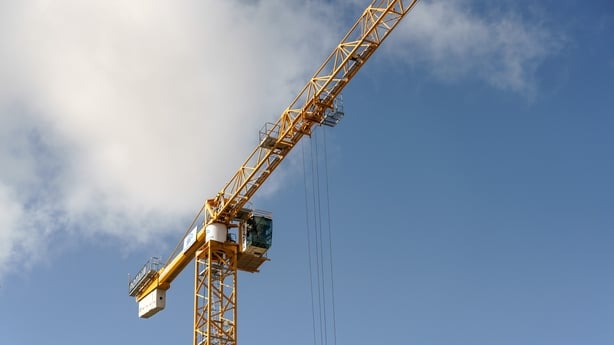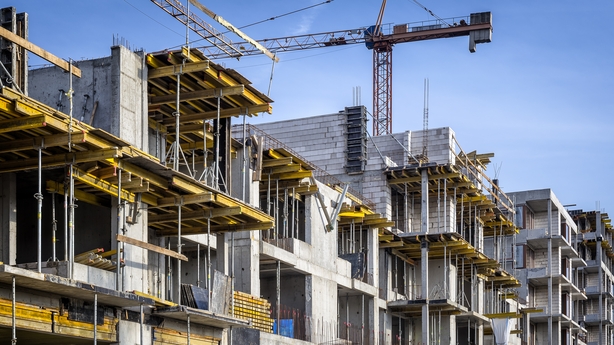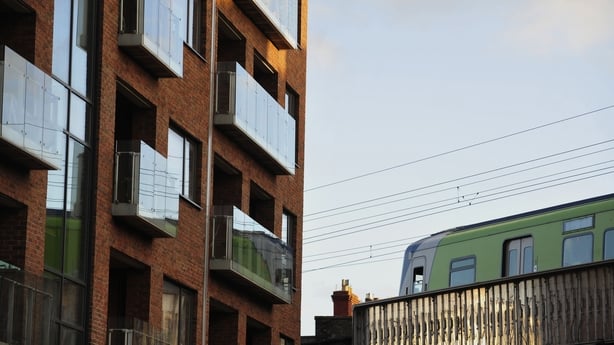It feels particularly apt for an Irish economist to use an analogy about umbrellas to make a point about housing. Conall MacCoille has picked two of the nation's favourite topics to illustrate the laws of supply and demand.
Just because house prices went up during the Celtic Tiger even though there were loads of homes being built, Mr MacCoille, the Chief Economist at Davy stockbrokers, told Prime Time that it doesn’t mean that the new houses caused the price increases.
When there’s rain you see more umbrellas – but umbrellas don’t cause rain, the example goes.
For economists like Mr MacCoille, housing is viewed through the same prism as any other commodity. When there’s more of it, prices should come down. If prices continue to rise, that’s not because of the supply – it’s in spite of it.
"In fact, house prices would have been considerably higher had supply not increased," Mr MacCoille noted about the Celtic Tiger years.
For a time after the crash, housing affordability wasn’t a problem. The economy contracted and demand collapsed. But now it’s the issue of a generation.
It matters again whether umbrellas cause rain because the Government’s solution to the problem is to increase supply. In contrast, some are arguing strongly that not all new homes will lead to cheaper prices more generally.

There’s a worry that there’s too many expensive rental apartments in the pipeline.
Housing is qualitatively different – and price doesn’t work in the same way as it does for say, umbrellas, the contention goes.
If you’re humming Rihanna to yourself at this point, you’re not alone.
The Government is targeting an average of almost 33,000 new homes a year between now and 2030. The ambition in the coalition’s Housing for All plan is to "support home ownership and increase affordability".
But it’s not as simple as ramping up supply, Dr Aidan Regan, a political economist at University College Dublin, told Prime Time.
Other factors, such as location, property size and surrounding amenities, also feed into house prices.
"You could build 100,000 homes in Leitrim tomorrow and, in all probability, it's not going to make much difference to prices in Dublin, but it may actually make a difference to prices in Leitrim itself or in Sligo."
Read more from Prime Time's Housing Week:
The staggering generation gap in the housing market
How everything is different for today's first-time buyers
The data behind the story: Housing really is less affordable than in the past
Should the Government try to push home values down?
Even building 100,000 new homes in Dublin would only reduce prices in the capital by 1.5%, he added.
"A house that was €350,000 will be €345,000. Does that solve the issue of affordability? Not really."
That fault line of opinion over supply is becoming even more pronounced with the growth in objections and legal challenges to new developments.
Investment funds
Ireland needs more apartments. We have the lowest number in Europe, despite a growing population and an increasingly diverse household size.
"We are absolutely obsessed with this idea of a heteronormative married couple about to have a family, when in fact, that is way less than half of the type of households we have in this country," Dr Ronan Lyons, an economist at Trinity College Dublin, told Prime Time.
"If we don't take action now, we won't get the housing to accommodate the diverse way of living that we already have."
It looks like the market is starting to respond.
Last year, more than 5,000 apartments were built in Ireland – a quarter of all new supply. The pipeline for future dwellings reflects a similar trend.
For the first time, planning permissions for apartments have surpassed houses. Under the large-scale Strategic Housing Development process, it’s even more pronounced. Planning permission was granted for 25,403 residential units in 2020, of which 5,908 were houses and 19,495 were apartments.

A belief that that new supply won’t solve affordability issues is a key driver of objections and legal challenges to new developments.
While height, density and the protection of geese and bats might be among the local reasons for opposition – others are looking at the big picture.
Planning permission was granted for almost 1,600 build-to-rent apartments in Drumcondra in Dublin despite a campaign of opposition that included arguments that the complex would drive up the cost of that land, making other residential development in the city more unaffordable.
On Dublin’s south side, plans for more than 600 apartments in Milltown were met with 135 submissions, including objections that claimed there would be no "community gain" from the 90% build-to-rent development.
Developers like Michael O’Flynn told Prime Time that they’re following Government policy, which dictates that 40% of developments must be on "brownfield" urban sites. It’s more sustainable and reduces urban sprawl – but they’re more expensive to build on.
"I wish people would accept that, a lot of the time we are providing development, it's in conjunction with publicly approved policies," Mr O’Flynn said.
In many case, those urban sites, according to Mr O’Flynn, will be forward sold to investment funds for rental.
"I'm tired of explaining to some people who really don't want to listen that unless we have a viable development, you have no development. Viability is generally defined by a margin of 15% profit approximately on your costs and your likely outcome."

The cost of building some apartments would be more than owner occupiers would pay, he added.
"Without those institutional investors, there are an awful lot of apartments that would not have been built."
But for campaigners like Dr Rory Hearne, a social policy academic at Maynooth University and the author of Housing Shock, supply on those terms is a distortion of the market.
Large private investors can set the price or rent and leave homes empty, he told Prime Time.
"In cities like London where they have a much higher rate of this type of investment, there are large tracts of properties lying vacant."
The problem, as Hearne sees it, is the dominance of funds.
"If these institutional funds were providing a small part of housing, I would have no issue, but in Dublin half of the units being built are apartments and 90% to 95% of these are forward purchased by institutional investors.
"They are completely out of bounds to home buyers."
Commentary like Hearne’s frustrates his economic counterparts.
"I get that these are objections on the basis of principle not for their own self-interest, but there's no empirical evidence to back up the claim that constructing build-to-rent apartments will make things worse," said Dr Lyons.

"Pretty much every rigorous study of supply that's out there, whether it's for Ireland or for other countries, confirms that other things being equal, if you have a higher amount of supply, housing becomes more affordable."
The trend towards large build-to-rent blocks may not be permanent, Marian Finnegan, the Managing Director of Residential at Sherry FitzGerald, adds.
"You have to remember these apartments are being financed by private equity. It's not going to continue to supply into a marketplace if it feels that the market is overstocked."
Keeping smaller landlords in the market is crucial to address the dominance of investment funds, she argued.
"I don't mean tax incentives, I mean stop disincentivising small landlords and actually just allow them to remain in the market.
"You'll find that supply will become much more robust than it is now."
The State's role
Most of those who have concerns over investment funds, and even many who don’t, want the State to play a bigger role in the housing market.
"We are in this housing crisis because the State withdrew and radically reduced its role in delivering social and affordable housing," said Dr Hearne.
While the Government’s Housing for All strategy does plan for a significant ramping up of social and affordable homes – 13,000 per year, on average, heading towards 2030 – 2021 is off to a slow start.
Sinn Féin has set the bar even higher, saying it would build 20,000 new social and affordable homes a year, starting this year.
But there’s scepticism as to whether local authorities have the expertise and the capacity to scale up to those numbers. Ireland also doesn’t have a State builder, so who is going to construct all these units?
Like so many aspects of the housing system, the danger is a whack-a-mole scenario where increasing one tenure, like social homes, reduces the capacity to build another, such as homes for private purchase.
Maintaining a balance of supply is key to progress, according to Ms Finnegan.
"If you break it down to the different component parts, every part of the housing market has a need for more construction activity. So, the balance is not to let the priorities of one overcome the priorities of the other."
The political will
The political imperative to crack the housing nut isn’t lost on anyone in Leinster House. Ultimately, Dr Lyons believes, there is a cohort of people in their 20s and 30s who have not had their housing needs met in recent decades.
"A lot more rental housing and a lot more social housing would remove a lot of that anger," he said.
Housing for All was only launched in September, so although 2021 offers an incomplete picture the 20,000 homes that were built does illustrate the direction things may be going.
Although the final numbers haven’t been published for social and affordable housing they are expected to hit around 6,000 units, leaving the remaining 14,000 homes built last year for rent and purchase.
Some 5,000 of those are one-off homes, and as such are not for sale in the windows of estate agents.
The plan has yet to run for a full year, so it’s too early to deliver a report card. But, for now, the supply of new, private homes remains tight. The plan’s targets won’t be fully met for another three years, which is a long time if you want to buy or if your rent is enormous.

The Government says it has policies to make sure the market isn’t skewed too far in the direction of large, build-to-rent developments.
Initiatives like Croí Cónaithe, when it’s launched, will effectively subsidise apartment building in certain areas so they can be sold to owner occupiers.
Demand-side measures are also there to help with affordability, Ms Finnegan noted.
A shared equity scheme is coming this year, and the Help to Buy initiative remains in place.
"So, the affordability gap should narrow somewhat in the short and medium term," Ms Finnegan said.
"I'm actually really optimistic that we're getting there."
But with house price inflation of 13% over the last year, the housing challenge remains significant, said Dr Regan.
"There's a lot of negativity around, and people are angry. There's a real sense of frustration because of unequal access to housing."
Buyers and renters have their umbrellas ready. It needs to rain sooner rather than later.
This week, online and on television, Prime Time is examining the issue of a generation – housing. You can read more articles in the series at rte.ie/primetime.







